Art: Landscape Painting: Studio or Plein Air?
By Raymond J. Steiner
ART TIMES Jan/ Feb 2013
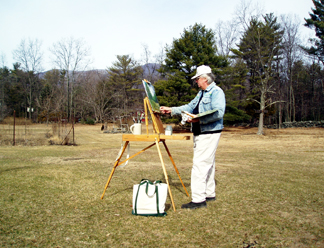 RJS painting in his "back yard" RJS painting in his "back yard" |
Some do both — I, for example, paint primarily en plein air and bring my completed canvases into my studio where I set them up on an easel and “study” them for days, even weeks, to see if my landscape “speaks” to me, sometimes adding a touch of color or splash of light to enhance my original “statement”. The bulk of the landscape painting process, however, is done alla prima (“all at once”) and out-of-doors. (Hence, the occasional “touch-ups” of color blobs and scrapes while I am back in my studio.)
This is a routine I learned from Susan Silverman, a fine landscape and figure painter from Cornwall, NY. Although I’d been sketching since childhood, I’d never taken a formal art class — in fact, had been advised by many artists and teachers I’ve come to admire and respect not to take classes (“You’ll only have to unlearn their idiosyncrasies and mistakes as you mature into your own style” was a common refrain) — so when I began painting about a dozen years ago, I asked Susan if I could accompany her during her plein air excursions to watch her at work.
Although I never really got the hang of the brush, I did manage to make some credible landscapes with a palette knife — but the important thing is, was that Susan taught me how to look, how to see nature. On our drives to and from different locations in and around Orange and Ulster Counties in upstate New York, she would point out colors, shadows, interesting land forms, glancing light — in short, nature in all its manifestations.
In my novel, The Mountain (set in Woodstock and its environs), my main character, Jake Forscher, a would-be landscape painter, learns from Birge Harrison that if he wants to be a convincing landscape painter, then he must paint “out in nature”. Birge Harrison, though a character in my book, was actually a real-life painter-teacher who taught at the Art Students League of New York’s summer classes in Woodstock, New York. It was because of Harrison and some of his colleagues that, back in the day, the Woodstock school was known far-and-wide as “the best landscape school in the world”.
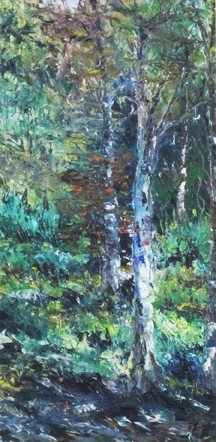 "Birches" by RJS o/c |
Though I included it in the novel, Harrison’s “mini-lesson” to the fictional Jake Forscher had long been known to me through Harrison’s own writings as well as comments from his many students I’d profiled over the years, so even before I started painting landscapes myself I had already taken his words to heart. His “lesson” was fairly simple: if you want to paint believable landscapes, then paint them on their own turf, so to speak — Susan brought his words alive.
Most know that it is color and light that are a painter’s mainstays, but just what is “color” and “light”? Light, as any painter can testify, is a fickle mistress and, even if it does “exist”, is maddeningly inconstant, forever changing before our eyes. (My protagonist, Jake, learns more about this later on in the novel from his friend Joe ((also fictional)), as they paint side-by-side on Joe’s property outside of Woodstock “proper”).
Harrison taught his students that colors do notactually “exist” but are only impressions taken in by our individual sense of sight – and, furthermore, those that we do perceive are only “half the story” since there are “colors” both above and below our range of seeing. The fact is, he taught, that the color vibrations come to us not only as visual “color” but also as sensations of heat and/or sound! “We can only ‘see’ the ‘colors’ within our visual range, but,” he claimed, “we can still feel and hear those that escape our sight.”
His point (whether “scientific” or not) was that, while outdoors, these out-of-our-visual-range colors still affect us, still “inform” our rendition of nature. I don’t know if he had ever arrived at the now-known discovery (through the rainbow and the prism) that light itself, that mistress of caprice, wascomposed of colors, some (as he taught), which cannot be seen by the human eye.
In any event, he insisted that by painting indoors, in the studio, you would not be able to paint a convincing landscape because you were not getting the “full Monty” (not his words, mine). He would say, “It’s not enough to make it look like a tree, you have to make it feel like a tree, smell like a tree — and, you can’t do this if you do not let the total you — all of your senses, conscious and unconscious — experience a tree”. (I don’t recall if I heard or read about one of the French Impressionist plein air landscape painters asking a colleague if he thought, “a bird could fly through the tree” he had just painted on his canvas). You get the point.
Harrison furthermore insisted that you had to put yourself into the tree, become “one” with raw nature, so to speak — none of which you can do if you confine yourself to the studio. To hammer home his point, Harrison also suggested that his students go to the Met and take another look at some of the Impressionists’ beach scenes. “Look closely and you can see the sand embedded right there in the painting, proving that they painted out-of-doors.”
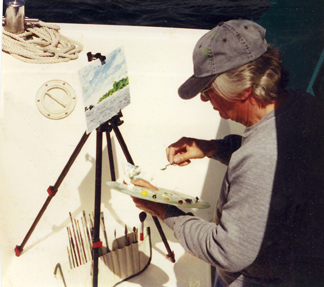 RJS on the deck of a House-Boat in Northern Germany RJS on the deck of a House-Boat in Northern Germany |
In my past 30-odd years of interviewing, profiling, critiquing, and reviewing artists, I can’t say that I disagree with Harrison. I’ve seen paintings that I know were painted indoors — too “finished”, too meticulously limned, too “polished” (“licked clean” is the way some used to put it). From my own experience and observation of the few landscapes I’ve painted indoors (a night sky, for example), they often appear too studied, too well defined, too “conceived” rather than “experienced’ in the raw.
Before the French Impressionists came on the scene, landscape painters in the past (and, of course, during and after) did so most commonly from sketchesor drawings (usually pen, pencil, charcoal, conté crayon, watercolor, etc.)done out-of-doors which were then brought into the studio where they served as "reference notes" for the finished product (the "well-licked" version). Incidentally, there are periodic exhibitions of these drawings which are (for me) intrinsically more interesting since they were done when draftsmanship still counted and are much more spontaneous, "on-the-spot," impressions than the often-overblown oil "machines" (a 19th Century description, not mine) produced later in the studio. So "polished" were they, that when the plein airistes came on the scene, most critics of the day were appalled, claiming that it looked as if the Impressionists used a gun instead of a brush to cover their canvases with paint.
Making obvious allowances for the differences in paintings done in the gardens of Versailles as opposed to those in some rugged woodland in the Catskills, there is a niceness to studio-painted landscapes as opposed to the sometimes spontaneous, sometimes edgy, almost always tentativenessfound in those done in plein air —inevitable when fending off bugs, snakes, wind, cold, avoiding direct sunlight, putting on or taking off clothes depending on the weather, (and of course, dodging wind-borne sand), etc., — giving them at least an air of authenticity.
Wide-brimmed hats or "billed" caps (not worn backwards!), high boots, bug spray, fingerless gloves for the hardy who enjoy painting outdoors in the winter, thermoses of hot or cold drinks (or, perhaps, a flask of something “medicinal”) — even umbrellas that attach to the Julian easel, which can protect canvases from direct sun, sudden cloudbursts and snow squalls — all help — but, as my friend Chen Chi used to say, “you should always make room for chance, for you never know how fortuitous it might prove in the end” (spelled out in his book, Heart & Chance: Chen Chi Watercolor Paintings). Chi’s advice notwithstanding, I once had a blast of wind blow my canvas off the easel and against my chest — leaving me (fortuitously?) with a pretty credible abstract landscape imprinted on the front of my sweatshirt.
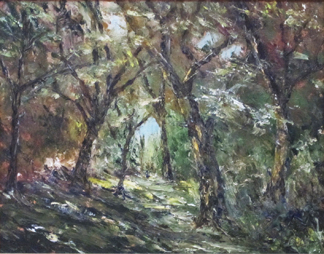 "Wooded Path" by RJS o/c |
Though it’s been some time since I’ve painted with Susan Silverman, I still carry her words with me today. I’ve since painted side-by-side outdoors with friends Linda Richichi, Annie Hofstatter and Cheryl Post in rural areas of New York State, as well as on a 5-day house-boat trip through the lock-connected canals and lakes of Northern Germany with my friends Jörg Iwan and Jacky Sparkowsky (though I was the only one painting), and with Heinrich J. Jarczyk high above the Rhone River in the French Alps — learning more each time.
In recent years, I've tended not to "partner up", but to go off on my own to paint alone — as I did (in 1999), for example, on the east coast of Ireland, south of Dublin, in the west at the Cliffs of Moher and, here in the States, along the rocky New England coast and the beaches of Florida. Although I once enjoyed the camaraderie of having a "sounding board" nearby, I am, at bottom, an "isolatoe" — jealous of my solitude (some say "obsessively"). My study/studio, for example is "off limits" to most, my preference being to plumb my own depths—without distraction. (My former study — the one that went up in flames in April 2009 — used to have a shade that pulled down over my doorway that read: GO AWAY!) So…I now paint alone.
Anyway, I primarily paint landscapes and almost exclusively with a palette knife (mostly to avoid getting overly “fussy” with a brush), and although I’m not quite sure my trees smell like trees, I rather like the rough-hewn spontaneity that my paintings often evince. Accordingly, aside from the occasional, abandoned and dilapidated stone walls I sometimes come across in deep woods that, in the past, served as boundary lines — portions of which I might include in a painting — and one of which, incidentally, separates nearby untended “Catskill Mountain” woods from the cleared land that contains our home and my study/studio outbuilding — I assiduously avoid including any signs of human “habitation” (although, early on, I did do a painting of an outbuilding in Garrison, NY — still in my study) to keep clear of the straight lines necessary in depicting roofs, walls, doorframes, windows, etc., preferring instead to use my erratic knife strokes which give me the usual, spontaneous, heavily impastoed paintings I enjoy making.
In addition, what further impels me to paint outdoors is that there is a sense of expansive freedom that I enjoy en plein air that I do not feel within the confines of my studio. And not merely physical freedom, but an aesthetic freedom to make my painting say what I choose, to move that bush over there, that boulder over here — even to begin with a certain patch of light and then completely change its surroundings simply because it was that patch of light I was really interested in. Another old story: Camille Pissarro was once painting in an open field when the owner, a farmer, quietly walked up behind him, then stood watching him as he painted. After a few minutes, he asked Pissarro, “How come there are three trees in your painting when there’s only two out there?” The old Impressionist answered, “Look behind you!” Yes — that kind of freedom.
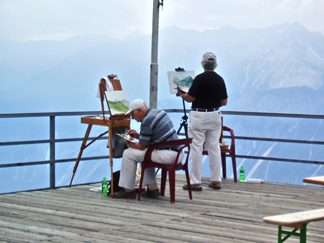 Heinrich J. Jarczyk (center foreground) Heinrich J. Jarczyk (center foreground)and RJS painting in the Alps |
Back when artists used to come upstate to Woodstock’s “best landscape school in the world”, big-time, mucky-muck, New York City-bound studio painters who emulated the old-timers that "sketched and then painted", used to snidely dismiss these “woods stompers” as, “Oh, those ‘Hudson River’ painters!” Who knew that history would be lauding those “woods stompers” as artists of “The Hudson River School” (with capital “t” and “s”), now a well-respected bunch whose landscapes are almost universally admired? And, again, who knows? My paintings might well be disregarded as “mere daubs” that I applied by shotgun by some now or future critic or art historian — so, I repeat, this is only one man’s opinion and, as we all know, history has a quirky way of making even the most astute art pundit appear foolish and / or ignorant. I prefer the plein airistes because it’s the way that I choose to paint landscapes. But, again, that’s my taste, my preference, my method.
Were I primarily a figure painter, or still life painter, and only a “sometime” landscape painter, I would in all probability be singing a different tune.For instance, I much prefer the precise verisimilitudeof a studio-painted still life or nude — which might be better painted indoors (unless, of course, you’re painting something called “Nude in a Snowstorm” or “Still Life in a Tsunami”).
In the end, all creations are acts of will. Your “solution” to creating a particular work of art cannot be reached through being familiar with some all-embracing “rule” of method — no science, logic, reason, “should” or “ought” really applies. An individual’s work of art is arrived at by insight, commonsense, and knowledge. It’s all a matter of taste, really — and what works for you. And who knows? I may soon have to admit the downside of painting outdoors — aside from bugs, sun, snakes, wind and sand, and so-forth, there’s the schlepping of all of my paraphernalia over hill and dale and setting up my Julian easel on top of some long, steep hill. Age is taking its toll, I have to admit — (but I’m not so sure I’d give up the knife — even if I start painting still lifes and nudes).
Though I am no fan of “hot-point” slogans, trendy catch-phrases, and other such “revelations”, I leave you with one of my favorite aphorisms, which I am told comes from the Qu’ran: “If you want to talk to God, go the Mosque; if you want to hear His answer, go to the desert”. Well, I have no nearby desert, but right on the other side of the crumbling wall that surrounds me, I have that large tract of “lovely, dark, and deep” woods where I can see and hear “answers”, all over the place — and the only “footprint” of humanity I find, is mine.
